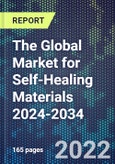Revolutionizing Longevity and Sustainability: Unraveling Opportunities Across Aerospace, Automotive, Electronics, and More
Inspired by natural biological systems, continuous efforts are being made to mimic natural materials and integrate self-healing capabilities into coatings, polymers and polymer composites. Research on self-healing materials and coatings has grown significantly in the last decade, as they attractive for extending asset life and improving safety in response to environmental changes. The need for sustainability use of oil-based materials is of increasing importance and the use of self-healing materials and coatings can greatly increase their lifetime.
Self-healing materials have the ability to autonomously sense and repair damage, extending product lifetime and provide the basis for long-term reliability. This will this avoid or reduce the costs of repair and greatly improve safety.
The Global Market for Self-Healing Materials 2024-2034 provides a comprehensive analysis of the rapidly growing global self-healing materials market. It offers detailed quantitative revenue forecasts from 2015-2034, segmented by end use sector (aerospace, automotive, electronics, energy, construction, coatings, healthcare etc) and region (North America, Europe, Asia Pacific, Rest of World).
The report analyzes key market drivers, latest product innovations, technology readiness levels, IP landscape, SWOT analysis and commercial activity across major applications such as self-healing composites, concrete, batteries, elastomers, electronics, and coatings. Over 40 leading companies are profiled including product portfolios and IP.
Report contents include:
- Quantitative Revenue Forecasts
- Granular 10-year projections from 2015-2034 for total market and by 12 key end use sectors
- Regional market value predictions for North America, Europe, Asia Pacific, Rest of World
- Analysis of market size and commercial activity for new technologies
- Technology Analysis
- Comparative assessment of extrinsic vs intrinsic self-healing mechanisms
- Technological review of latest innovations: vascular networks, vitrimers, organic coatings etc.
- Evaluation of material formulations including polymers, hydrogels, concrete etc.
- Competitor Landscape
- Profiles of 44 leading companies developing products and IP. Companies profiled include A2O Advanced Materials Inc., Autonomic Materials, CompPair Technologies, Green Basilisk, Hyundai Motor Group, Mimicrete, NEI Corporation, and Tandem Repeat
- Review of patents shaping new product development
- Assessment of partnerships, strategy and R&D focus by sector
- Application Segmentation
- Overviews of self-healing use cases: composites, batteries, electronics, biomedical etc.
- Commercial activity mapping and product pipeline by aerospace, construction, coatings, healthcare etc.
- Technology readiness analysis, SWOT analysis and growth opportunities by vertical
- Strategic Recommendations
- Macro growth drivers, market challenges and investment opportunities
- New product roadmapping support for executives, investors and startups
- Market entry and expansion considerations by sector and geography
This product will be delivered within 1-3 business days.
Table of Contents
Companies Mentioned (Partial List)
A selection of companies mentioned in this report includes, but is not limited to:
- A2O Advanced Materials Inc.
- Autonomic Materials
- CompPair Technologies
- Green Basilisk
- Hyundai Motor Group
- Mimicrete
- NEI Corporation
- Tandem Repeat
Methodology

LOADING...








